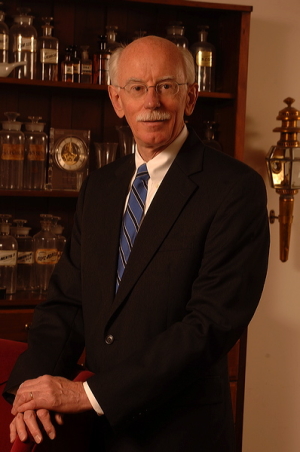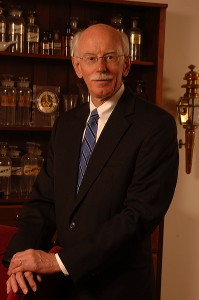Article by Stephen C. Schimpff, MD | “Doctor’s Orders” curated by editor Sasha Yakhkind
When I began to think about becoming a doctor — sixty years ago while in high school — I thought of medicine in terms of being a healer. I imagine each of you have had similar thoughts before and now during medical school. But what does it mean to be a healer and how does one go about becoming one?
The art of healing is very important in medicine. There can be a difference between being a modern day physician and being a healer. All societies have healers — wise men and women, shamans, medicine men and people of other names. The “old time practitioner” was almost always a healer but many physicians today are not. It is an issue of interest, training, time and prioritization.
Healing means to make whole or re-establish harmony and wholeness. It comes from the same root as holiness — a connection infrequently recalled in today’s medical practice. The healer is the guide in the process. He or she can be a healer without necessarily curing a disease. To paraphrase Sir William Osler, a good doctor tends to the person who has a disease rather than just the disease itself.
Healing requires training just as much as it takes training to learn how to do an examination or an endoscopy. It requires good mentors but they seem to be in short supply in most medical schools, and post graduate training programs seem to “train out” rather than “train in” the healing skills.
A report in the Annals of Internal Medicine suggested eight characteristics of the physician healer: He or she does the little things like makes eye contact; takes time and listens; is open (shed a tear if appropriate); finds something to like or love in each patient (“walk the wounded path with them”); removes barriers (doesn’t sit behind a desk); lets the patient explain (“An essential part of healing is allowing the patient’s understanding of their illness to be spoken and received”); shares authority (remembers that the patient is ultimately in charge); and is committed and trustworthy in the patient’s eyes. This article was commented upon in a lovely essay “What Makes a Physician a Healer” by Dr. Sharon Orange, a primary care physician in California.
One can be a physician yet not a healer and not all healers need to be physicians. A mother’s kiss “heals” a child while the child’s body slowly resolves the skinned knee. Many complementary medicine practitioners have the attributes of the healer; they take time to listen deeply.
I have been posting a series about primary care and in the first of the series was a story about a patient I called Monica. Her primary care physician did not really listen to her and as a result missed the obvious diagnosis. Instead she was referred to specialist upon specialist upon specialist and had multiple tests, procedures and a surgery and yet none of these physicians took the time to understand the underlying issue. Each was competent in their field but each left her in a sort of limbo, never focusing on what actually had brought her to medical attention in the first place. No one was a healer for her. (And it cost a king’s ransom when just a few minutes of time would have sufficed.)
Cardiologist Dr. Mimi Guarneri in her book “The Heart Speaks” recalls the teaching of one of her professors. He was elderly, seemed to take forever talking to each patient and was not to be rushed. The residents were frustrated that time was wasting. At the end of rounds one day he said that he wanted to teach the residents and students something that they would otherwise never learn during their training. He said that it was important to “let your patients tell their stories and if you really listen, they will give you the diagnosis. If you don’t listen, you will miss the answer that is right in front of you.”
Her professor’s point was that a symptom is often a “downstream” manifestation of a body’s unconscious crying out for help. So, as described in “Healers on Healing,” a hemorrhoid may not be just a hemorrhoid. It may be a manifestation of liver cirrhosis which in turn is the result of years of alcohol excess which in turn is the product of unresolved psychological issues. A careful history may illicit that guilt persisting from long ago yet hidden from the patient’s consciousness has been the cause of the alcohol abuse. Helping the patient with self-discovery of the underlying guilt and working through it will be true healing. It may result in less alcohol abuse but the cirrhosis may nevertheless very well be permanent. The point is that just sending the patient for surgical removal of the hemorrhoids, appropriate as that might be, misses the real illness and the opportunity to truly heal. Of course, the physician will need to be a careful listener and non-judgmental in order to be effective.
The message is that nearly all diseases occur in a patient who has a narrative to offer. The doctor’s role — if he or she desires to be a healer — is to listen to that narrative and through it uncover the deeper issues. Once found these may be not only a surprise to the physician but to the patient as well.
You can become a healer. It is not hard. Mostly it just takes time — time listening in a nonjudgmental manner to your patient. The patient will tell you what you need to know.
Author’s note: This essay was edited from one of a series on trust and healing that appeared on KevinMD.
Dr. Stephen C Schimpff, MD is a quasi-retired internist, professor of medicine and public policy, former CEO of the University of Maryland Medical Center, senior advisor to Sage Growth Partners and is the author of The Future of Health Care Delivery: Why It Must Change and How It Will Affect You.





